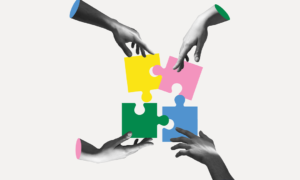
Can a leader help to shape the resilience of their team?
In the constantly evolving, fast paced environments that leaders often find themselves in, resilience is not just beneficial; it’s essential.
Resilience isn’t about gritting your teeth and pushing through; it’s about nurturing a state of well-being to allow you to feel at your best and enjoy work. Resilience in teams can lead to increased productivity, greater employee retention and can contribute to a strong positive company culture. (Gifford, 2021)
Resilience is a state of mind that acts as framework which underpins our wellbeing. It allows us to bounce back from setbacks, reflect and learn from any challenges so we can grow stronger as a result. Learning is key, we don’t just want to be able to bounce back, we want to foster an ability to reflect and learn and use our learning to approach situations differently in future.
Having a basic understanding of the link between neuroscience and resilience can provide leaders with actionable insights and strategies on improving well-being and empowering employees to experience more resilience.
What is neuroscience?
The role of neuroscience is to explain behaviour in terms of the activities of the brain. How the brain marshals its billions of individual nerve cells to produce behaviour, and how these cells are influenced by our environment. It shows how our brain processes and responds to stress and adapts to challenges. All this information is key to understanding our well-being.
Neuroscience helps leaders better understand how their brains work, and how they can use this knowledge to improve their leadership skills.
Can a leader help to shape the resilience of their team?
The good news about resilience is that it is a set of skills, behaviours and actions that can be learned and developed. That is, we can activate it in ourselves and cultivate it in others.
The human brain is remarkably adaptable, exhibiting neuroplasticity. Thought patterns, emotional responses, and behaviours can be consciously rewired. By modelling and reinforcing new ways of thinking and responding, leaders can nurture and influence resilience.
Modelling is of utmost importance as we learn by observing others.
As leaders, we need to be visible to our teams, demonstrating how we navigate change and challenges. When we embrace adversity, learn from mistakes, and maintain composure in a crisis this can have a highly influential effect on our teams. When team members witness leaders embracing adversity their mirror neurons (specialist brain cells) come into play. (Marco Lacoboni, 2005) They mirror these responses mitigating their own stress levels, fostering a culture of learning and adaptability. By modelling resilience leaders create a ripple effect that encourages team members to navigate difficulties with a growth mindset.
Four ways for building increased resilience in ourselves and our teams
1. Develop increased self-awareness
- Start by being aware of your feelings, emotions and mental state
- Recognise your strengths and areas for development
- Know when to ask for help
- Use situational leadership to address challenges as the arise
- Use your team’s skills wisely to support your own skill set
Being empathetic is a great deal easier if we are self-aware. It is well known that empathy builds connection (Davis, 2013). Remember the remarkable mirror neurons? Mirror neurons or specialist brain cells have a unique capacity, they “fire” when we perform an action and when we observe an action being performed by someone else. They literally allow us to “mirror” the behaviour of others, which is where their name comes from.
As a leader you have a choice to ripple, enthusiasm, positive energy, and confidence to inspire your team. Understanding that your state is contagious emphasises the importance of self-awareness and self-regulation. (Barside, 2002)
Science tells us that we leak cortisol the stress hormone through the skin, so if you are stressed your team will literally feel it. (Swart, 2023)
2. Mindfulness and mindset
- Deep breathing – Taking a deep breath brings more blood supply and therefore oxygen to the frontal cortex.
- Non-judgemental observations – Observe thoughts feelings and body sensations without evaluating them as good or bad.
- Present moment awareness – pay attention to what is happening right now without projecting ahead to the future or back into the past.
- Reduce reactivity – consider the gap between stimulus and reaction. Choose how to respond.
Many meditation practices focus on attention, with good reason, research has found that meditation has been found to combat habituation, stopping us from paying attention to new information in our environment. (Elena Antonnova, 2015) This is a hugely important result for meditation practice, as attention is part of what makes us effective in the world. Learning, memory, creativity and seeing things through to the end are all influenced.
3. Encourage physical activity
- Hold walking meetings
- Encourage regular breaks for stretching and movement
- Invest in standing desks
- Offer flexible works hours for exercise
- Include physical activity in your social events
Physical activity stimulates the release of neurotransmitters like dopamine and endorphins, which can improve mood and reduce stress. Exercise also stimulates neurogenesis, which is the creation of new neurons (nerve cells) primarily in the brain. This process can potentially enhance cognitive abilities and memory retention.
4. Define shared vision and goals
Ensure that all team members are aligned with a common vision and shared goals. When everyone understands the purpose and objectives of the team, they are more likely to stay focused and motivated during challenging times.
- Encourage your team to set challenging goals – more challenging goals lead to increased task performance, persistence and motivation. (jessica Hopfner, 2021)
- Monitor progress and give regular supportive feedback – this feedback loop enhances learning and adaptability. Celebrate Small “wins” to keep the feel-good chemical dopamine flowing
- Design teams consisting of 5- 8 people and encourage collaboration- bonding and entrustment is most effective in this size team
- Create opportunity for shared decision making
- Encourage reflection on successes and challenges when projects end
Purpose-driven work activates the release of oxytocin, making work feel less like a chore and more like doing interesting things with friends.
Teams that share a common purpose are more likely to collaborate effectively and achieve their goals. Oxytocin is just one of several neurotransmitters that play a role in team success. Others include dopamine and serotonin. These neurotransmitters help to create unity in teams creating strong and lasting foundations for collaboration and achievement. (Ph.d, 2018)
By incorporating these neuroscience informed strategies into your work environment and practices, you can create a culture of resilience where team members feel supported, empowered, and equipped to navigate challenges effectively.
Barside, S. G. (2002). The Ripple Effect Emotional Contagion and It’s Influence of Group Behaviour. JSTOR, 1. Retrieved from https://www.jstor.org/stable/3094912
Davis, K. (Director). (2013). Brene Brown on Empathy [Motion Picture]. Retrieved from https://www.youtube.com/watch?v=1Evwgu369Jw
Elena Antonnova, P. C. (2015). More Meditation, Less Habituation? The Effect of MIndfulness Practice on the Acoustic Startle Reflex. Plos 1 , 1. Retrieved from https://www.ncbi.nlm.nih.gov/pmc/articles/PMC3132583/
Gifford, J. A. (2021). Employee Resilience An Evidence Review . London : Chartered Institiute of Personnel and Development.
jessica Hopfner, N. K. (2021). Goals Missed, Self Hit , Goal Failure and thier Affective MOtivational and Behavioural Consequences. Frontiers , 1. Retrieved from https://www.frontiersin.org/journals/psychology/articles/10.3389/fpsyg.2021.704790/full
Marco Lacoboni, I. M.-S. (2005). Grasping the intentions of others with one’s own mirror neurons . Pub Med , 1.
Ph.d, P. J. (2018, June 6). Greater Good Magazine. Retrieved from Greater Good Science Centre: https://greatergood.berkeley.edu/article/item/how_oxytocin_can_make_your_job_more_meaningful
Swart, D. T. (2023, September Monday 25th ). No 1 Neuroscientist, Stress leaks through your skin, is contagious and gives you belly fat. (S. Bartlett, Interviewer)
Leaders, Managers & Supervisors
Enhance performance and team dynamic by better understanding leadership behaviour.
HR Professionals
Identify the requirements of your people and the strategies that will help them perform better.
Consultants
Help your clients create a work environment in which people are enabled to perform to the best of their abilities.






